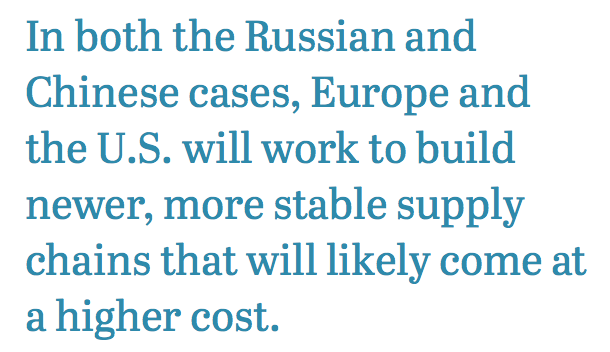
Bailard’s SVP and Chief Strategist – Wealth Management, Jon Manchester, CFA, CFP® and Chief Investment Officer, Eric Leve, CFA, tackle the global factors at play as we look to economic recovery.
September 30, 2022
Eric Leve, CFA: The Great Financial Crisis (GFC) stood as one of the global economy’s worst shocks since the Great Depression and, seemingly, everyone became a macro forecaster trying to understand the root causes of what had transpired and what the entrails foretold for investors. Among the outcomes were that the underpinnings of the global economy were so rattled, the housing market in the U.S. was so impaired, and U.S. municipalities were so weakened, that economic growth was tepid and inflation was modest for the next decade.
Today we face what feels like another epochal transition for the global economy: geopolitics is becoming increasingly critical as companies move away from historically cheap, but politically volatile trading partners such as China; as Western Europe’s historical supplier of natural gas (Russia) becomes a bitter enemy; and as what was termed transitory inflation appears to have much greater lasting power. So, with that preamble Jon, do you think “epochal” is an overstatement and, if so, how do you view the global landscape ahead of us? Put more simply, when do you think we’ll get back to “normal” and what might that look like?
Jon Manchester, CFA, CFP®: I think history will be the arbiter of whether current events are epochal, but I do want to first dig into your comments on Russia and China. The period prior to the GFC may prove a high water mark for globalization for the next generation. Since that time, trade as a proportion of global economic output has declined from more than 60% in 2008 to close to 50% today, in line with levels seen in 2002. The rise of populist leaders around the globe hobbled long-held alliances (notably the UK and Europe), while historically independent autocrats have found common purpose (particularly Russia and China).

Although both nominally Communist, Russia and China were bitter rivals in the 20th century Cold War. More recently, they have developed a disturbing codependency. Russia can fill much of the gap in China’s oil and gas demand and expand China’s political reach to the Atlantic. China can provide desperately needed capital to a relatively poor Russia and, at the same time, distract Western powers with their aggressions up and down the western Pacific. Russia never grew wealthy, but its endowments of raw materials gradually made it a critical supplier to the Western world, especially in the aftermath of perestroika. 2022 has been a brutal wake-up call. European and broader dependence on Russia for oil, gas, nickel, and palladium is a dangerous and unreliable relationship.
China’s scope for most of the Cold War was regional, but with a gradual opening beginning with Deng Xiaopeng, its economic ambitions became global and its cheap manufacturing replaced that of newly-rich Japan and South Korea as feedstock to the Western world. The past several years have heightened concerns of relying on China for goods, especially technology-related ones, as China’s interests have become less mercantile and more militaristic.
In both the Russian and Chinese cases, Europe and the U.S. will work to build newer, more stable supply chains that will likely come at a higher cost. For the dependability this will bring, the cost is worthwhile, even if it means more expensive goods for consumers.
Eric: Your comments regarding Europe’s dependence on Russian energy stand out to me. Western Europe’s industrial core has been a beneficiary of several major world events: the movement of low-wage labor from southern Europe in the 1950s, the later influx of another source of cheap labor after the fall of the Berlin Wall, and for the past couple of decades, some of the most inexpensive natural gas in the world. With the prospect of higher costs for fuel in the future and a historical demographic benefit (younger, cheaper workers) becoming a demographic burden (fewer new entrants into the workforce as Baby Boomers retire), Europe will need to find a new source of competitive advantage.
Even as Europe leads the world in adopting alternative fuel sources, the region’s manufacturing companies will need creative solutions to keep up with foreign competitors. For now, that means new relations with gas producers in Northern Africa and, in the future, a broader group among the Gulf States. But let’s get back to the bigger question: what do we think the path out of this economic and market downturn will look like compared to the one that followed the Global Financial Crisis?
Jon: There is a stark contrast between the period following the GFC and our current experience. The GFC itself exposed systemic issues in housing and banking around the world that caused a deeper and longer recession that I expect this one to potentially be, but more critically, it left wounds that led to the relatively anemic economic growth in the decade that followed.
The current downturn was precipitated by a global pandemic that caused significant dislocations in supply and demand as well as historically-large fiscal and monetary responses by the major Western governments. Working down that accumulated debt will be a multi-year process and may point to marginally-higher interest rates. The greatest contrast though is that the forces coming out of the GFC were largely deflationary, and looking forward, inflationary pressures are more likely to challenge policymakers, corporations, and consumers.
There is a bit of a silver lining here though. Inflationary pressures tend to be a meaningful impetus for technological change. Higher wage pressures motivate companies to develop technologies that enhance productivity and, at the margin, put greater emphasis on utilizing more capital than labor for production. In parallel with a similar process in the 1970s when the world enjoyed the incredible advances in semiconductors, the advent of personal computers, the large-scale business adoption of computing and internal networking and the birth of some of today’s great technology giants, the investments that we are already seeing could result in another technological revolution. One which, like the previous one, could support higher margins for companies across essentially all sectors.
Eric: That said, the Federal Reserve’s (the Fed’s) current challenge to contain inflation should be considered in the context of the broader, generational issues we’ve been discussing. Baseline inflation is likely to be higher. Central banks including the Fed, the Bank of England, and the European Central Bank may consider higher inflation targets, possibly raising them from current levels of 2% to 3%. This would dramatically lower the burden of beating inflation and reduce the risk that central banks (on their own) throw economies into recession. There are various forces supporting this.
As a mass of Baby Boomers leave the workforce and a smaller number of Millennials enter it, higher wage pressures aren’t simply a European phenomenon, but one that affects many of the world’s largest and most developed economies. The prioritization of security of supply (over timeliness and cost) will translate into a high degree of on-shoring of manufacturing globally. This will, by definition, come with higher costs. Finally, many technology and technology-enabled companies are dependent on an array of metals, suggesting that we may be on the cusp of another secular tailwind to commodity prices.
Jon: In many ways I see the recent, dramatic market moves as a fundamental reset that could restore the value of diversification in investment portfolios. For so much of the post-GFC era, the overriding mantra was TINA: as in, “there is no alternative” to stocks, and mostly to mega-cap tech stocks. Today we see bond yields at levels in line with those prior to the GFC. With the Fed Funds rate at 3.25% (and expected to go higher), cash is no longer “trash,” and it reverts to a credible alternative to stocks. With higher yields, bonds have a greater ability to provide diversification to equity returns than they did when they offered near-zero yields.

Within the equity universe, we are seeing greater dispersion in valuations relative to history, making areas outside of mega-cap growth compelling. Even international stocks, which have been the bane of investors for more than a decade, are enjoying an interesting reset. Dollar strength has hurt investment in this area over the past year, but that headwind can easily turn into a tailwind with dollar weakness. When that tailwind does come, exporters from countries with weaker currencies will look much more competitive Finally, the mix of sectors offered by international stocks is much more diversified than the basket of U.S. stocks. In a global recovery, this mix that includes higher yielding, more stable companies could balance some of the high growth that dominates U.S. indexes.
Eric: I couldn’t agree more. I don’t see the next ten years looking much like the post-GFC era. While U.S. stocks may provide returns comparable to what they’ve done over the long-term, I think, as you imply, that intelligent asset allocation will be critically important to good investment outcomes.
Recent Insights
Country Indices Flash Report – April 2025
U.S. policy and global equities swung wildly during the month as ‘Liberation Day’ was followed by a 90-day pause in many tariffs and the administration’s harsh tone toward Fed Chair Jerome Powell softened. These America-centered policy shocks led to broad dollar weakness: the euro and pound reached three-year highs. EAFE had declined more than 10% before fully recovering, ending April in positive territory.
April 30, 2025
Quarterly International Equity Strategy Q1 2025
Non-US assets found renewed vigor to begin 2025, in sharp contrast to late 2024. Echoing the first Trump administration eight years ago, U.S. policy uncertainty weighed on the dollar and U.S. equities, while stimulus and reform improved sentiment elsewhere (the Eurozone in particular). The resulting spread of MSCI EAFE over MSCI USA was the widest first-quarter return differential since 1986. While reduced policy visibility may dampen real investment and activity across many countries and industries in the short-term, we believe recent volatility may provoke broader re-examination of allocation to non-US equities, and a constructive starting point for longer-term performance.
April 28, 2025
Quarterly Technology Equity Strategy Q1 2025
The Bailard Technology Strategy posted a 1Q25 total return of -9.35% net of fees—ahead of both the benchmark index (S&P North American Technology Index) and the competitor-comprised benchmarks. The Morningstar U.S. Open End Technology Category returned -9.98% and the Lipper Science and Technology Fund Index returned -10.88%, while the S&P North American Technology Index returned -11.43%. Over longer time periods of 3, 5, and 10 years, the Strategy’s net returns continued to lead the competitor’s peer benchmarks—quite substantially, as seen in the table to the right.
Despite market volatility in Q1, we have not significantly altered our positioning. Our view is that nothing is broken in tech, and we remain convicted in our investment process. With prices and valuation changing dramatically, we expect to optimize our positioning by bolstering or adding high-quality companies trading at attractive discounts to long-term value. We anticipate stabilization in industry fundamentals and fiscal policy in the latter part of this year.
April 16, 2025
Keep Informed
Get the latest News & Insights from the Bailard team delivered to your inbox.